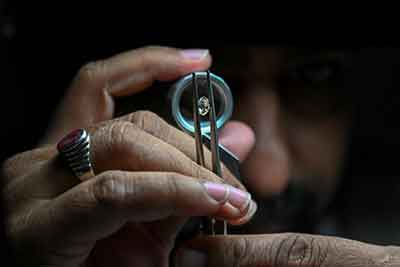Date: 08/02/2023
Relevance: GS-3: Indian Economy and issues relating to planning, mobilization, of resources, growth, development and employment.
Key Phrases: rough lab-grown diamonds, isometric cubic, high temperature (HPHT), Gemological Institute of America (GIA), irradiation, chemical vapour deposition.
Context:
- In the latest Budget, Union Finance Minister has abolished the Customs duty on imports of seeds used for manufacturing of rough lab-grown diamonds.
Key Highlights:
- The move is aimed at boosting the exports of LGDs from India and also reducing dependence on imports for the key input, i.e., seeds and equipment.
- The duty now stands nil from 5 per cent earlier.
- This is expected to encourage imports of seeds to manufacture rough lab-grown diamonds locally and reduce the imports.
- In order to boost research and development capabilities, the Centre has extended financial assistance to the Indian Institute of Technology Madras for a period of five years.
- This is expected to create an ecosystem for LGDs in India.
Lab-Grown Diamonds (LGDs)
- Naturally-formed diamonds are pure carbon, crystallised in the isometric cubic form beneath the earth’s crust.
- Lab-grown diamonds (LGDs), on the other hand, are manufactured in laboratories with either of the two methods — chemical vapour deposition (CVD) or high pressure, high temperature (HPHT) using a chemical composition.
- LGDs have physical and optical properties similar to that of natural diamonds.
- A common eye can’t distinguish between a natural diamond and an LGD and it requires a trained gemologist and sophisticated equipment to differentiate the two.
- The size, clarity, cut and colour of LGDs make them suitable substitutes for natural diamonds, especially when the availability of natural diamonds becomes scarce due to depleting reserves and escalating costs.
How are the lab-grown diamonds produced?
- Unlike natural diamonds that take centuries or several millenia to be formed below the crust of the earth under extreme heat and pressure, the LGDs are made in laboratories using either the CVD or HPHT method.
- It takes less than a month to make a distinctively-shaped crystal.
- The process starts with a seed — a slice of another diamond — on which the LGD is created.
- The HPHT method mimics the high-pressure, high-temperature conditions that occur under the earth to form a natural diamond.
- The seed and graphite carbons are exposed to extreme temperatures (1,500 degrees Celsius) and with extremely high pressures to make an LGD.
- The LGDs made in China are mostly produced using HPHT method.
- The CVD method is more popular in India.
- CVD is a chemical process in which the seed is heated up to 800 degrees in a sealed chamber filled with molecules of carbon-rich gas such as methane.
- These gas molecules are broken down into carbon and hydrogen atoms, which get deposited on the seed giving it a shape of square, tabular diamond crystal.
- This process also requires heat or irradiation to give the crystal a colour effect.
The Environmental Impact Of Lab Diamonds
- Energy Usage:
- Most lab diamond growers require 250 – 750 kilowatt hours (kWh) to produce a rough carat.
- Fortunately, lab diamond companies are answering the call to reduce energy consumption by using more renewables to make the growing process more energy efficient.
The Environmental Impact Of Mined Diamonds
- Waste & Water Usage:
- A study comparing lab-grown and mined diamonds by consultancy Frost & Sullivan found that mining diamonds produces 4,383 times more waste than growing diamonds.
- The same study revealed that diamond mining uses 6.8 times as much water.
- Water Quality:
- Mining affects water quality and the availability of water resources within the area.
- There is potential for acid mine drainage and contaminant leaching, and the erosion of soils and seepage of mine wastes into surface waters can be severe.
- For example, hundreds of cattle died after drinking water from the Odzi River in Zimbabwe, located downstream from a diamond processing plant.
- Biodiversity destruction:
- On average, mining companies move 250 tons of earth per carat of mined diamonds.
- Excavation and mining activities disturb land, often leading to biodiversity destruction and making the land unusable for any future uses — even after the mining operations are closed
- Seabed and marine life destruction:
- In marine mining, diamond deposits are sometimes found on the seabed, so seabed matter needs to be removed to access the diamonds beneath.
- The recovery process can take two to ten years.
India’s Export Potential
- Still, at a nascent stage, the LGDs are gradually gaining ground in the country, while in other parts of the world, the commercial marketing of LGDs started about 10 years ago.
- In India, the share of lab-grown diamonds in overall diamond business is presently just 2-3 per cent.
- In India, lab-grown diamonds are mostly used for jewelleries and exports.
- About 80 per cent of the cut and polished LGDs are exported, while only 20 per cent are consumed locally.
- According to Gems and Jewellery Export Promotion Council (GJEPC) data, LGD exports from India in December 2022 stood at ₹844 crores, up 8 per cent from ₹779 crores in December 2021.
- For April-December the LGD exports were up 54 per cent year-on-year at ₹10,587 crores.
- The US and Europe are the key markets for India’s CVD lab grown diamonds.
- With government support, the industry expects India’s LGDs will be competitive globally.
Conclusion:
- The government’s step to abolish the Customs duty on imports of seeds used for manufacturing rough lab-grown diamonds will definitely help in making it a promising sector in coming future.
Source: The Hindu BL
Mains Question:
Q. What are lab-grown diamonds? What is India’s export potential? (250 Words).






















